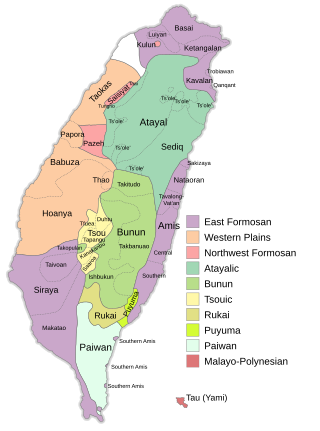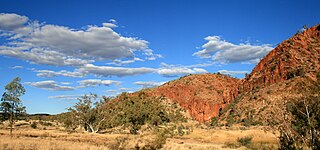Related Research Articles

The Indigenous languages of Australia number in the hundreds, the precise number being quite uncertain, although there is a range of estimates from a minimum of around 250 up to possibly 363. The Indigenous languages of Australia comprise numerous language families and isolates, perhaps as many as 13, spoken by the Indigenous peoples of mainland Australia and a few nearby islands. The relationships between the language families are not clear at present although there are proposals to link some into larger groupings. Despite this uncertainty, the Indigenous Australian languages are collectively covered by the technical term "Australian languages", or the "Australian family".

The Formosan languages are a geographic grouping comprising the languages of the indigenous peoples of Taiwan, all of which are Austronesian. They do not form a single subfamily of Austronesian but rather up to nine separate primary subfamilies. The Taiwanese indigenous peoples recognized by the government are about 2.3% of the island's population. However, only 35% speak their ancestral language, due to centuries of language shift. Of the approximately 26 languages of the Taiwanese indigenous peoples, at least ten are extinct, another four are moribund, and all others are to some degree endangered.

The Pama–Nyungan languages are the most widespread family of Australian Aboriginal languages, containing 306 out of 400 Aboriginal languages in Australia. The name "Pama–Nyungan" is a merism: it is derived from the two end-points of the range, the Pama languages of northeast Australia and the Nyungan languages of southwest Australia.
Jiwarli is an Australian Aboriginal language formerly spoken in the Pilbara region of Western Australia. It is a variety of the Mantharta language of the large Pama–Nyungan family.
Australian Kriol also known as Roper River Kriol, Fitzroy Valley Kriol, Northern Australian Creole or Aboriginal English is an English-based creole language that developed from a pidgin used initially in the region of Sydney and Newcastle in New South Wales, Australia, in the early days of European colonisation. Later, it was spoken by groups further west and north. The pidgin died out in most parts of the country, except in the Northern Territory, where the contact between European settlers, the Chinese and other Asians, and the Aboriginal Australians in the northern regions has maintained a vibrant use of the language, which is spoken by about 30,000 people. Despite its similarities to English in vocabulary, it has a distinct syntactic structure and grammar. It is a language in its own right and is distinct from Torres Strait Creole.

The Gamilaraay or Kamilaroi language is a Pama–Nyungan language of the Wiradhuric subgroup found mostly in south-eastern Australia. It is the traditional language of the Gamilaraay (Kamilaroi), an Aboriginal Australian people. It has been noted as endangered, but the number of speakers grew from 87 in the 2011 Australian Census to 105 in the 2016 Australian Census. Thousands of Australians identify as Gamilaraay, and the language is taught in some schools.

The Kanyara languages are a pair of closely related languages in the southern Pilbara region of Western Australia.

The Adnyamathanha language, also known as yura ngarwala and other names, and Kuyani, also known as Guyani and other variants, are two closely related Australian Aboriginal languages. They are traditional languages of the Adnyamathanha of and the Kuyani peoples, of the Flinders Ranges and to the west of the Flinders respectively, in South Australia.
Gurindji is a Pama–Nyungan language spoken by the Gurindji and Ngarinyman people in the Northern Territory, Australia. The language of the Gurindji is highly endangered, with about 592 speakers remaining and only 175 of those speakers fully understanding the language. There are in addition about 60 speakers of Ngarinyman dialect. Gurindji Kriol is a mixed language that derives from the Gurindji language.
Marra, sometimes formerly spelt Mara, is an Australian Aboriginal language, traditionally spoken on an area of the Gulf of Carpentaria coast in the Northern Territory around the Roper, Towns and Limmen Bight Rivers. Marra is now an endangered language. The most recent survey was in 1991; at that time, there were only 15 speakers, all elderly. Most Marra people now speak Kriol as their main language. The remaining elderly Marra speakers live in the Aboriginal communities of Ngukurr, Numbulwar, Borroloola and Minyerri.

Mudburra, also spelt Mudbura, Mudbarra and other variants, and also known as Pinkangama, is an Aboriginal language of Australia.

Kaytetye is an Australian Aboriginal language primarily spoken in the Northern Territory north of Alice Springs by the Kaytetye people, who live around Barrow Creek and Tennant Creek. It belongs to the Arandic subgroup of the Pama-Nyungan languages and is related to Alyawarra, which is one of the Upper Arrernte dialects. It has an unusual phonology and there are no known dialects.
Thalanyji and Binigura/Pinikura are two closely related languages from the Pilbara region of Western Australia. They are part of the Kanyara subgroup of the Pama–Nyungan language family.
Yinikutira, also recorded as the Jinigudira, are the traditional Aboriginal owners of the land along the Ningaloo Coast in the area of the Exmouth Peninsula in Western Australia now known as the Cape Range National Park. The area is within the Gascoyne region.
The Mandi, otherwise known as Manthi, were an Aboriginal Australian people of Western Australia.
The Tjuroro, also known as the Jurruru, were an Aboriginal Australian people of the Pilbara region of Western Australia.
The Tharrkari, also referred to as the Targari, are an Aboriginal Australian people of the Gascoyne region of Western Australia.
The Thalanyji, also spelt Thalandji, Dhalandji, and other variations, are an Aboriginal Australian people in the Pilbara region of Western Australia.
The Djiwarli, also written Jiwarli, are an Aboriginal Australian people of the Pilbara region of Western Australia.
The Binigura people, these days usually spelt Pinikura, are an Aboriginal Australian people of the Pilbara region of Western Australia.
References
- ↑ Burduna at Ethnologue (25th ed., 2022)

Bayungu at Ethnologue (25th ed., 2022)
- ↑ W24 Purduna at the Australian Indigenous Languages Database, Australian Institute of Aboriginal and Torres Strait Islander Studies (see the info box for additional links)
- ↑ Endangered Languages Project data for Payungu.
- 1 2 Austin, Peter (1988). "Classification of southern Pilbara languages". Papers in Australian Linguistics. 17: 1–17.
- ↑ Dixon, Robert M. (2002). Australian languages: their nature and development. Cambridge University Press. ISBN 9780521473781.
- 1 2 "W24: Burduna | aiatsis collection". collection.aiatsis.gov.au. Archived from the original on 31 October 2018. Retrieved 17 December 2021.
- ↑ Austin, Peter (1988). "Aboriginal languages of the Gascoyne-Ashburton region" (PDF). La Trobe Working Papers in Linguistics. 1: 43–63 – via La Trobe University.
- 1 2 "Purduna". Sorosoro. Archived from the original on 5 January 2011. Retrieved 17 December 2021.
- 1 2 3 4 Austin, Peter (1991). "Double case marking in Kanyara and Mantharta languages, Western Australia" (PDF). La Trobe Working Papers in Linguistics. 4: 19–36 – via La Trobe University.
- 1 2 3 4 Austin, Peter (1981). "Proto-Kanyara and proto-Mantharta historical phonology". Lingua. 54 (4): 295–333. doi:10.1016/0024-3841(81)90009-7.
- 1 2 3 McConvell, Patrick; Kelly, Piers; Lacrampe, Sébastien, eds. (5 April 2018). Skin, Kin and Clan: The dynamics of social categories in Indigenous Australia (1st ed.). ANU Press. doi: 10.22459/skc.04.2018 . ISBN 978-1-76046-163-8.